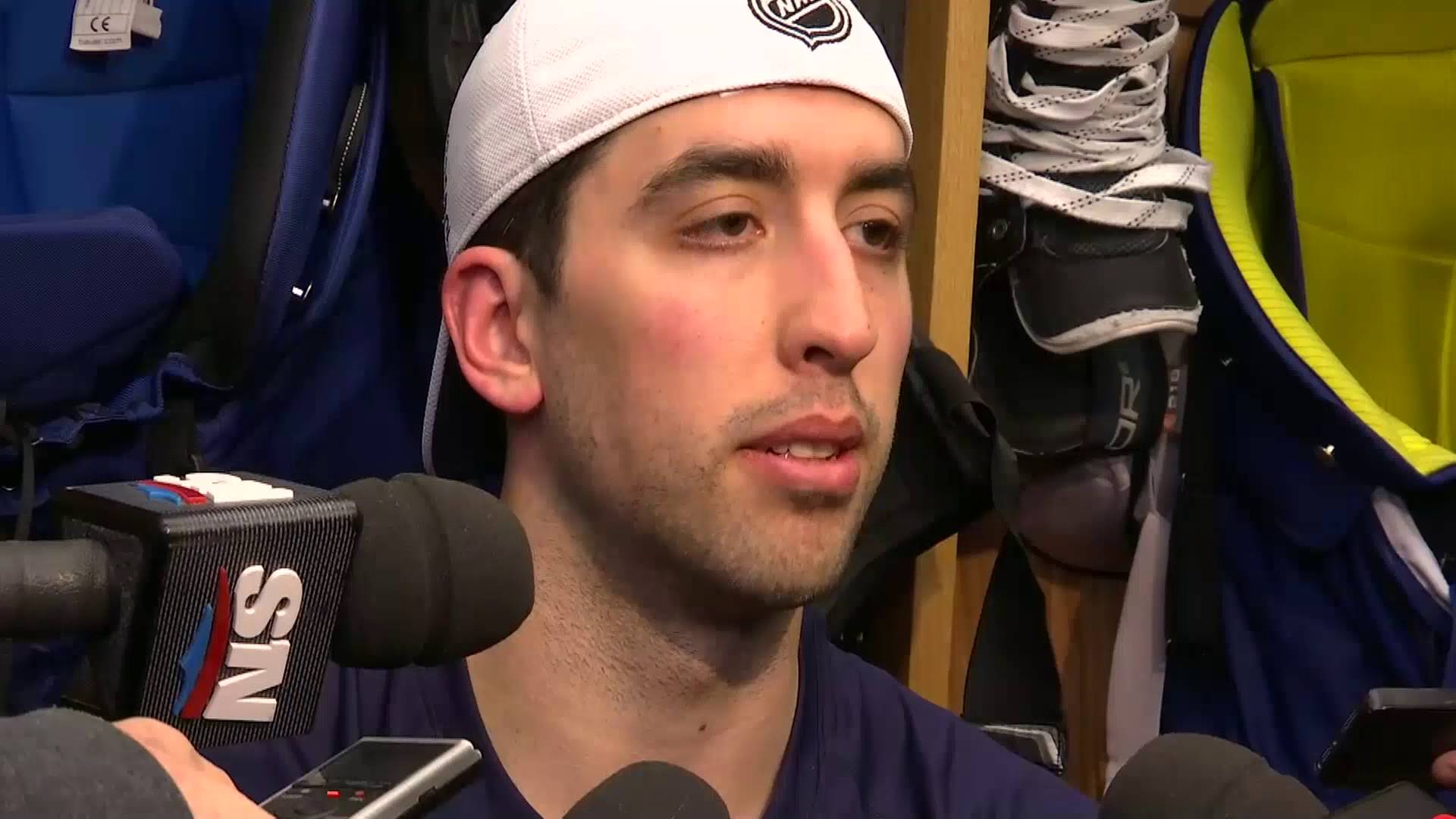As the Toronto Maple Leafs continue to cross names off their RFA checklist, the Jared Cowen situation is a cloud of mystery hanging over their cap situation at the end of July.
We know that the Leafs’ plan to execute a buyout during the June window did not go as expected due to a grievance filed by the NHLPA on Cowen’s behalf. As of today, we don’t know when the arbitration process will conclude, but it has to take place sometime in the next couple of weeks so that the Leafs can get their cap situation in order heading into the new season.
Both sides in D Jared Cowen $2.15 M buyout grievance with Leafs have been in touch, but no hearing date set. Leafs need those cap savings.
— Lance Hornby (@sunhornby) July 25, 2016
What We Know
Here’s the Coles Notes version of where things stand today based on what’s been reported so far:
- While the Leafs stand to gain a $650,000 cap credit for the buyout in 2016-17, Cowen’s side stands to lose $3 million due to the under-26 buyout rules dictating that only a third of the salary is paid out. Cowen was due $4.5 million this upcoming season.
I - Buyout rules also state that a player still recovering from an injury incurred during the regular season cannot be bought out. The Leafs shut Cowen down after acquiring him as a precaution to avoid re-injury knowing Cowen has an ongoing hip issue. Whether he was unfit to play in the first place is at the crux of the grievance.
I - Jared Cowen and his agent admitted that he was healthy and wanted to play – either with the Leafs or Marlies – after he arrived in Toronto. His agent admitted “any doctor” would clear Cowen to play, but also that his client’s hip wasn’t 100%.
We’re going to take the time to get Jared right. He’s not injured, but he’s not right. Any doctor would clear him to play. But there are compensation issues when your hip isn’t 100 per cent, other parts of your body are affected. Rather than having him sit as a healthy scratch with the Leafs or the Marlies, we’re going to have him go see some people and get healthy.”
Cowen is back in Ottawa, but Valette plans to send him to the Mayo Clinic and some other specialists he knows. He’s 25 years old. We’ve got six months to get him back to being a good player. That’s our game plan for now.
– Elliotte Friedman’s 30 Thoughts
- Damien Cox also reported that the Leafs gave Cowen’s camp permission to talk to other NHL teams in advance of the buyout window.
I - Cowen later had surgery on his hip at his own doctor’s recommendation after the Leafs sent him home. He had been previously cleared to play in the AHL.
Does Cowen have a case?
First off, what changed after what appeared to be an amicable arrangement between the Leafs and Cowen about how the buyout was going to proceed?
As stated, Cowen wound up undergoing surgery, which would suggest that he found out through a specialist that his hip was in worse condition than initially believed. That could well mean his career is in jeopardy; at the very least, it hurts Cowen’s chances of catching on elsewhere. Cowen’s camp is therefore trying to salvage $3 million that he may never earn elsewhere in the league.
Cowen isn’t without a leg to stand on here. The optics of him and his agent’s statements aside, their opinions aren’t legally binding and they aren’t even particularly persuasive in the face of expert medical evidence to the contrary. If we are to assume it was the Leafs/Marlies doctors who cleared Cowen to play in the AHL originally (we don’t know that for sure), that would not automatically be dispositive evidence in the case. It’s also arguably self-serving in view of the Leafs wanting to buy him out.
Should the NHLPA provide evidence that Cowen wouldn’t have been cleared to play by a specialist after the trade – which could well be the case given the surgery took place and this grievance has been filed – there’s a compelling case to be made that Cowen was ineligible for a buy out.
On the other side of it, there is no one you would rather have in the GM’s seat than Lou Lamoriello in a situation like this as far as the Leafs are concerned.
Cap Implications
Jared Cowen carries a cap hit of $3.1 million, which would turn into a cap credit of $650,000 in 2016-17 due to Cowen’s age and the structure of his contract. As far as the impact on the 2016-17 cap, it’s plus or minus $3.75 million total.
The Leafs currently have $1.3 million in cap space with a 23-man roster that includes Cowen, Nathan Horton and Stephane Robidas. That is without Martin Marincin signed, and without a backup goaltender. Sparks is included in the current total at a cap hit of just $575,000, but if the Leafs sign Jhonas Enroth, he stands to make roughly $750,000 more than Sparks based on Enroth’s last contract ($1.25 million).
The Leafs’ lives are made much easier if afforded the space availed by Cowen’s buyout. They should be able to get Marincin and a backup signed for well under $4.85 million (current cap space plus Cowen’s buyout). There is also space that could be opened up by trimming the roster down from 14 forwards and eight or nine defencemen. They would be under the cap with some wiggle room, and would have enough space to include Jimmy Vesey’s $925,000 entry-level base salary if Vesey picks the Leafs.
If the Leafs were to lose the grievance, the cap situation starts to look tight without the use of Long Term Injury Reserve relief. Cowen, like Horton, would be eligible for LTIR, but the problem with using the LTIR option on either (or Robidas) is the potential implications of combining LTIR relief with performance bonus money.
Taking advantage of LTIR means that a team is actually over the cap but receiving relief for an amount as high as the total injured players’ cap hit(s). That doesn’t leave any wiggle room for performance bonuses, opening the team up to some potentially steep cap overage penalties. Over at Colligan Hockey, you can read more about how the “LTIR + bonus” cocktail proved a lethal one for Peter Chiarelli in Boston.
Auston Matthews is a safe bet to hit a number of performance bonus benchmarks this season barring injury, and the Leafs will have a number of other rookies on the roster with some bonus money to strive for as well. They’re also considered among the front runners for Vesey, who — wherever he signs — will be receiving a significant bonus package built into his contract (granted, Lamoriello may see a distinction between Matthews and Vesey when it comes to deserving those bonuses).
The Leafs may not be overly worried about cap penalties for 2017-18 given the amount of money coming off the books on July 1, 2017. Brooks Laich, Milan Michalek, Stephane Robidas, Colin Greening and (possibly) Jared Cowen are all on expiring deals worth a total of $17.25 million ($14.15m without Cowen).
The Leafs will not have any expiring contracts of much significance to deal with as of today, either, with Rielly, Gardiner, Kadri, Matthews and Marner locked up for three years or more, and Nylander for two more seasons.
Cap penalties, like all other forms of dead cap space, are generally something the team should do their best to avoid, however, given the Leafs don’t know for certain what their cap situation is going to look like a year from now.
Another option worth mentioning is the second buyout window that will open on account of the Leafs having a player (in their case, three) file for arbitration. For the Leafs, the window opens three days after Martin Marincin’s arbitration hearing on August 2 — whether it gets to that point or not — and lasts for 48 hours, provided the buyout is on a player with an AAV higher than $3 million. If the Leafs decide it makes more sense than risking a significant cap penalty for 2017-18 due to bonuses, the buyout on the $4 million Milan Michlaek is arguably the most sensible of their options at just $1.33 million for the next two seasons. This could become a reasonable option if the Leafs lose out in the Cowen grievance especially.



![Sheldon Keefe on the Maple Leafs’ struggling power play: “[We’ve scored] one out of 11 high-danger chances in tight to the net… We have been in those spots and haven’t converted” Sheldon Keefe, playoff press conference](https://mapleleafshotstove.com/wp-content/uploads/2024/04/keefe-pc-game-3-218x150.jpg)

![Jim Montgomery Post Game, Bruins 4 vs. Leafs 2: “[Marchand] still manages to get under people’s skin, yet he doesn’t cross the line” Jim Montgomery, Boston Bruins post game](https://mapleleafshotstove.com/wp-content/uploads/2024/04/jim-monty-pg-to-218x150.jpg)
























![Sheldon Keefe on the Maple Leafs’ struggling power play: “[We’ve scored] one out of 11 high-danger chances in tight to the net… We have been in those spots and haven’t converted” Sheldon Keefe, playoff press conference](https://mapleleafshotstove.com/wp-content/uploads/2024/04/keefe-pc-game-3-100x70.jpg)



![Jim Montgomery Post Game, Bruins 4 vs. Leafs 2: “[Marchand] still manages to get under people’s skin, yet he doesn’t cross the line” Jim Montgomery, Boston Bruins post game](https://mapleleafshotstove.com/wp-content/uploads/2024/04/jim-monty-pg-to-100x70.jpg)
